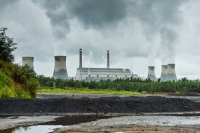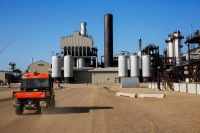Carbon capture is having a moment.
Companies such as Chevron are building technology to capture carbon dioxide from smokestacks while others such as Microsoft are investing in startups working to yank the greenhouse gas out of the air directly.
Governments and climate activists are pressing companies to eliminate their emissions, but there’s doubt whether solar, wind and batteries can do so alone. The United States, in particular, has focused on boosting carbon capture thanks to the Energy Department investing billions of dollars in the technology and attractive tax credits in the Inflation Reduction Act (IRA) for project developers. A growing array of science also shows that the world will need to capture carbon at a fairly vast scale in the coming decades to limit global warming to 1.5 degree Celsius.
Yet for all the momentum and growing need to decarbonize, the technology has drawn mounting opposition. The fossil fuel industry’s involvement, in particular, has raised the specter that carbon capture could be used to prolong oil and gas extraction, endangering the climate rather than helping protect it. Costs, too, could limit its utility, and there are questions whether the technology can even be scaled up in the first place.
These tensions were front and center at last year’s COP28 climate talks held in the oil-rich United Arab Emirates, where the technology was a central pillar of the summit’s agreement. In the coming years, the world will have to decide whether carbon capture can be deployed responsibly — and what to do with the CO2.
When should carbon capture be used?
There are two main ways machines are used to capture carbon. So-called point source carbon capture and storage (CCS) grabs CO2 at the smokestack of sites such as industrial plants. Other technologies pull already-emitted CO2 out of the ambient air, a process called direct air capture (DAC).
Point source can be deployed at oil, gas and heavy industry facilities. But research shows that the use cases where that would be beneficial to the climate are fairly narrow.
"The real utility of carbon capture is addressing the hard-to-abate emissions that can’t be dealt with,” said Ben Grove, carbon storage manager at the Clean Air Task Force, a climate research nonprofit.
One of those hard-to-abate sectors is cement, which accounts for about 8% of global emissions. While parts of the cement-making process can be electrified, some of the CO2 emissions from production are "fundamental to the process,” said Emily Grubert, an associate professor of sustainable energy policy at the University of Notre Dame.
Startups such as Brimstone are working on cement decarbonization, but most of the techniques to clean up cement are far from ready for mass commercialization.
"Unless you come up with a replacement for cement or a vastly different formulation, there’s not a way around those emissions without using something like CCS,” Grubert said.
Steelmaking is another industrial process with few immediate decarbonization pathways. While startups and incumbents are looking at ways to produce the world’s most used metal without the emissions, the costs are great and the industry needs to cut emissions rapidly.
In some cases, it may make more sense to retrofit a new steel plant with carbon capture technology rather than pursuing other avenues such as electrification, according to analysis from research provider BloombergNEF, which found that doing so could abate as much as 600 million tons of CO2 per year by mid-century.
Science shows that CCS largely shouldn’t be used when alternatives such as renewable energy are readily available. The oil and gas industry, though, is among the biggest backers of CCS, with companies looking to retrofit power plants and refineries with the technology. Doing so has proven challenging for the industry to date, but IRA tax incentives have created renewed interest. The industry sees it as a way to potentially continue pumping more oil and gas, including plans to use the captured CO2 to extract even more fossil fuels.
"Carbon capture will play a key part in helping all sectors of the global economy decarbonize, particularly those hard-to-abate areas where there are no easy routes available through electrification,” said Michael Tholen, sustainability and policy director at Offshore Energies U.K., which represents energy companies. "Here in the U.K. we are committed to accelerating its development across our closely integrated energy mix in support of the energy transition.”
There are cases where CCS could be used on existing fossil fuel plants responsibly, according to Jennifer Wilcox, principal deputy assistant secretary in the U.S. Energy Department’s Office of Fossil Energy and Carbon Management. She gave the example of new natural gas-fired power plants, of which nearly 5.7 gigawatts of new capacity were added in the U.S. in 2022, according to BloombergNEF data. The fuel overtook coal as the U.S.’s top source of electricity in 2016 and made up nearly 44% of the country’s power production.
"They’re providing stability [and] reliability to communities,” Wilcox said. "What you wouldn’t want to do is pull that reliability out when it’s actually not ready to retire.”
But multiple lines of research suggest that may not make economic sense. A 2020 study by Grubert found three-quarters of U.S. power plants will be ready for retirement by 2035. A March report from the Institute for Energy Economics and Financial Analysis, a non-profit that advocates for a transition away from fossil fuels, found that power generation with CCS could make electricity more expensive compared to alternatives, including renewable energy plus storage. A 2019 study in Nature Energy shows renewables outcompete carbon capture on cost as well.
Scientists estimate that by mid-century, the world will need to remove billions of tons of CO2 from the atmosphere annually to limit warming to the relatively safe level of 1.5C. Current capacity globally is measured in thousands of tons per year, so there’s a large scale-up that needs to happen. But deploying the technology needs to be done in tandem with decarbonizing the economy.
"Emissions reduction is priority number one,” said Vanessa Suarez, managing environmental justice adviser at Carbon180, an organization focused on carbon removal policy. "I think it’s also true that there’s two centuries worth of legacy emissions that we do have to clean up.”
What should be done with captured CO2?
A common concern about carbon capture is that the CO2 will go toward perpetuating business as usual, rather than contributing to meaningful emissions drawdown or addressing stubborn sources of greenhouse gas pollution.
While the majority of announced direct air capture projects plan to store CO2 underground, 19% will be utilized as a feedstock for sustainable aviation fuel (SAF), according to research from BloombergNEF.
Aviation is responsible for around 2% of global emissions, which is roughly on par with Japan or Germany. Decarbonization options are few and far between and utilizing captured CO2 for fuel could make sense.
Turning CO2 into a feedstock for SAF could help achieve "a double dividend” compared to just storing that CO2 underground, said Jonathan Foley, executive director of the nonprofit Project Drawdown. He emphasized that, even then, carbon capture should still only be applied at a small scale, rather than the billion-ton range that other research calls for, due to its high cost compared to switching to renewables.
The fossil fuel industry has different designs for CO2. Rather than using it to create synthetic fuels, it wants to inject it into aging oil and gas fields to dislodge remaining oil, a process known as enhanced oil recovery (EOR). The technique has been in use since the 1970s, but a number of oil companies want to scale it up. One of the biggest backers of DAC, Occidental Petroleum, has made it clear that some of its projects will use the CO2 to produce more oil. About 8% of CO2 captured will be used for enhanced oil recovery, according to the BloombergNEF analysis.
Some DAC startups have drawn a line in the sand, refusing to allow the CO2 they capture to be used for procuring more fossil fuels. Climeworks co-founder and Chief Executive Officer Christoph Gebald has said the company is only interested in "permanent underground storage, period,” and startup Heirloom has said that no CO2 removed by its technology will be used for EOR.
"I think that there should be guardrails for responsible carbon management for the broader industry as it develops,” said Vikrum Aiyer, Heirloom’s head of climate policy and external affairs.
Those guardrails are going to be necessary as the industry scales and more companies enter the CO2 cleanup business, spurred on by tax incentives and growing government investment.
"What happens if we come to a day where DAC is actually completely the opposite of what I thought it could be?” asked Suarez, who is working on a community-led DAC project sponsored by the Energy Department. "I hope we don’t get to that point. What motivates me is that it feels like we’re still in these early days, and I don’t want to step out of the fight now.”
























With your current subscription plan you can comment on stories. However, before writing your first comment, please create a display name in the Profile section of your subscriber account page.